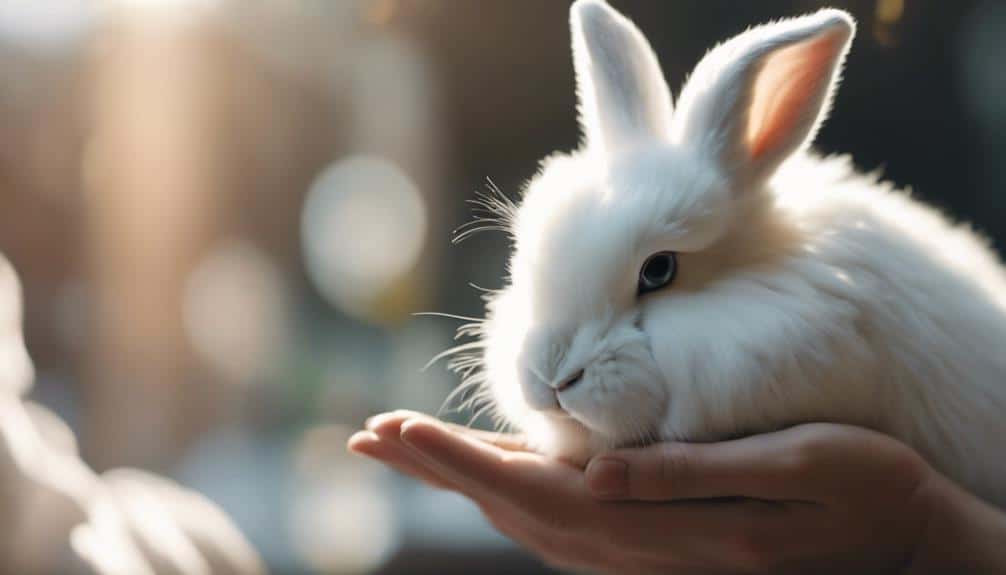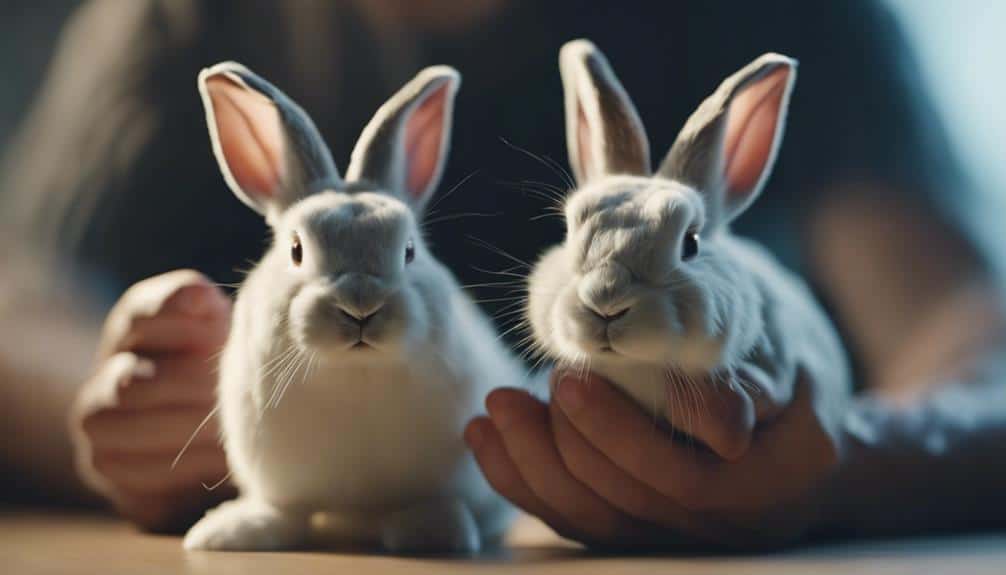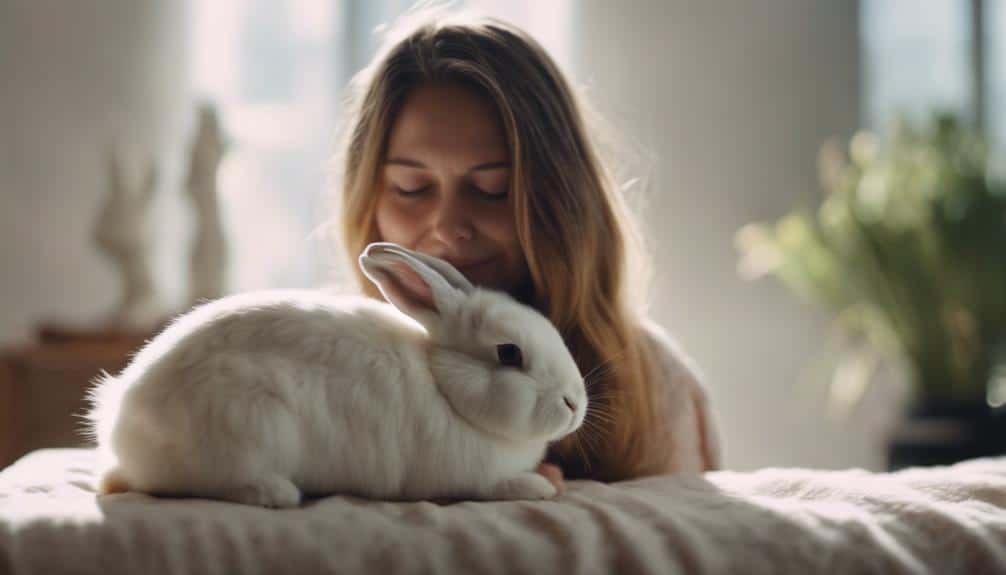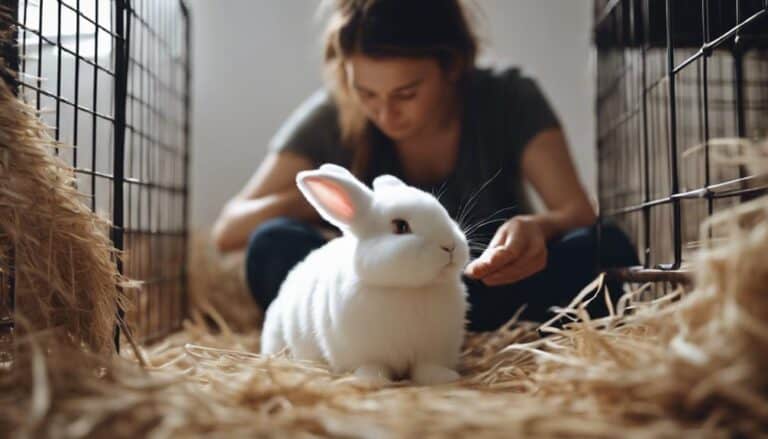Do bunnies like being petted? Well, bunnies actually enjoy gentle petting, especially on their forehead and behind their ears. It's important to approach them slowly to build trust and create a cozy space for their comfort. Plus, understanding their petting preferences can help strengthen your bond because each bunny has their own unique likes.
Keep an eye on their body language for cues. Their ears and tail movements can reveal their emotions, so it's important to pay attention. Building trust with your bunny takes patience, offering treats, and respecting their cues. Remember, bunny boundaries are crucial, so observe their comfort levels and avoid forcing interaction.
When petting your bunny, use the correct techniques like gentle strokes and be cautious with their ears. By improving their comfort during petting, you can enhance your relationship with your furry friend.
Contents
Key Takeaways
Bunnies really like it when you gently stroke their forehead and behind their ears. It helps them feel relaxed and happy. When you approach rabbits, make sure to do it slowly so they can trust you more.
Creating a safe and cozy space for bunnies is super important for them to feel comfortable. They love having their own little spot where they can relax and play.
It's also good to know what kind of petting your rabbit prefers. Some bunnies love being petted all over, while others might only like certain spots.
Every bunny has its own unique personality, so understanding what your bunny likes and dislikes is key to having a great time together. Pay attention to their cues and you'll have an awesome bond with your furry friend!
Bunny Preferences for Petting

When you pet bunnies, it's important to know what they like and how they feel comfortable to ensure a good time together. Just like people, rabbits have their own personalities that affect how much they enjoy being touched and petted. Some bunnies really love human interaction, while others might be more shy. Knowing your rabbit's petting preferences is key to building a strong bond with them.
A lot of rabbits enjoy gentle strokes on their forehead and behind their ears. These areas are usually sensitive and can make them feel cozy and happy. Take your time approaching your rabbit and pet them where they like it best to help them trust you and have a great time. It's crucial to create a safe and cozy space for your rabbit so they can feel secure and calm during petting sessions.
Understanding Rabbit Body Language
When you're watching rabbits, keep an eye on their ears, body position, and tail movements. If their ears are standing up, they might be curious or on alert. And if their body looks relaxed, it means they're probably feeling comfy and happy.
Pay attention to their tail too – if it's twitching, they could be excited or getting worked up. Understanding these cues will help you figure out how your rabbits are feeling and what they might do next.
Ears: A Rabbit's Signals
Rabbits use their ears to communicate a lot of feelings! When their ears are pulled tightly back, it usually means they're scared or feeling aggressive. On the other hand, ears that are pointed forward show that the rabbit is curious or interested in something. If you see their ears moving quickly, it means they're excited or on high alert. And if their ears are flicking back and forth, it could mean they're unsure or can't make up their mind about something.
When a rabbit's ears are relaxed and hanging loosely to the sides, it's a sign that they're feeling content and relaxed. By paying attention to these ear movements, you can really get a good idea of how your rabbit is feeling and what they might be thinking. Remember, rabbits rely on their ears to communicate, so understanding these signals can help you connect better with your rabbit buddy.
Tail: What It Means
Rabbits use their tails to express how they're feeling and what they're up to. If a rabbit raises its tail, it's probably feeling curious or excited. On the other hand, a rabbit may tuck or lower its tail if it's scared, stressed, or uncomfortable. Keep an eye out for tail wagging or thumping, as these could be signs that the rabbit is upset or trying to warn you about something.
To really understand what your rabbit is trying to tell you, it's important to pay attention to their tail language along with other body signals. This way, you can accurately interpret their emotions and reactions. This knowledge is key for communicating effectively with your pet rabbit and building a strong bond with them. By watching your rabbit's tail movements closely, you can get a better grasp of how they're feeling and what they might need.
Posture: Signals to Watch
Rabbits tell us a lot through how they hold themselves, showing their comfort and if they're up for some petting. When a bunny is chill and relaxed, it's a good sign they're okay with interacting. But if they seem tense, they mightn't be feeling like getting petted.
If you see them purring, tooth clicking, or leaning into your pets, they're happy bunnies! Keep an eye on their ears and tail too, as they can give you more clues about how they're feeling. Watch how they react to your petting to make sure both of you enjoy the time together.
Building Trust for Bunny Petting
If you want your bunny to trust you and enjoy petting, take it slow and respect your rabbit's space.
Start by gently introducing touch and pay attention to how your bunny reacts. This will help them feel comfortable and build a positive connection with petting.
Consistency, gentleness, and offering treats can make petting a safe and fun experience for your bunny.
Trust Through Patience
Building trust with your bunny through petting requires patience. To do this effectively, here are some key tips to keep in mind:
Firstly, approach your bunny slowly and with gentle movements. This helps create a calm atmosphere for your bunny to feel comfortable in.
During your interactions, make sure to offer treats and use soothing words. This will help your bunny associate petting with positive experiences.
It's important to respect your bunny's cues and body language. Let them set the pace during petting sessions, as this will help build trust over time.
If your bunny is touch-averse, you can try desensitization techniques. By gradually exposing them to touch in a consistent manner, you can help them become more comfortable with petting.
Respect Bunny Boundaries
When you want to pet a bunny, it's crucial to respect their boundaries to build trust. Approach them slowly and let the bunny decide when they're ready for some pets. Trust is key to making petting a positive experience.
Watch their body language to see how comfortable they are. Treats and praise can help reinforce good behavior during petting. Never force petting on a bunny; always follow their cues and preferences.
Correct Techniques for Petting Bunnies

Petting bunnies is a great way to bond with them and make them feel loved. Start by gently stroking your bunny's forehead with your fingertips. Many bunnies find this soothing and enjoyable.
Next, move on to petting your bunny's cheeks with light and soft strokes. This area is often a favorite for bunnies and can help them relax.
Be sure to lightly stroke your bunny's ears, being careful not to apply too much pressure. Some bunnies are sensitive about their ears, so watch their reactions closely.
Addressing Rabbit Fear of Touch
If your rabbit is afraid of touch, it's important to take things slow and be patient to help them feel comfortable. This fear might be due to past negative experiences or not being socialized enough. To build trust with your rabbit, you need to be patient and have positive interactions with them.
Start by gradually exposing your rabbit to touch and petting them while they're on the ground. This can help them get used to the sensation over time. Consistency is key in desensitizing your rabbit to touch, which can strengthen your bond with them. Older rabbits usually respond better to touch, but younger ones may need more time to adjust and feel at ease with petting.
Improving Bunny Comfort With Petting

Improving your bunny's comfort during petting sessions is all about understanding what they like and using gentle, calming techniques to make them feel good and strengthen your bond. Here are some tips to ensure both you and your bunny have a great time:
First off, pay attention to how your bunny reacts to different petting styles and areas of their body. See what they enjoy the most and adjust your approach accordingly.
Watch out for signs like relaxed body posture, purring, or tooth-clicking, which mean your bunny is happy and comfortable. If they start to tense up or show signs of distress, it's best to stop or change what you're doing.
When petting your bunny, go for soft strokes and gentle motions. Avoid sudden movements or putting too much pressure, as this can startle or bother them.
Frequently Asked Questions
Do Rabbits Like Getting Petted?
Rabbits really like being petted when you do it gently and respect their preferences. They show different reactions and communicate through their body language. It's important to understand how to pet them correctly and to build trust to make them feel comfortable. Each rabbit has their own behaviors, so it's important to be patient and gentle. By getting them used to being petted slowly, you can help them feel more at ease with it.
Do Bunnies Like to Be Cuddled?
Bunnies really like to cuddle! Many rabbits enjoy snuggling and being petted. When you cuddle with your bunny, they show their affection through bonding and love. It's a sweet way to strengthen your relationship and create a comforting experience for both of you.
Do Rabbits Like to Be Touched?
Rabbits enjoy being touched as a way to connect, bond, and show love. By knowing how they groom themselves, what they like in terms of touch, and how they express themselves, you can make sure to give them the space they need and build a strong bond with them.
Does Rabbit Like to Be Held?
If you want to hold a bunny, it's essential to consider what they like. By handling them properly and being gentle, you can make it a good experience for them. The key is to build trust and understand their boundaries to create a positive relationship between you and your rabbit.
Conclusion
So, bunnies have different likes and dislikes when it comes to being pet. If you pay attention to their body language and earn their trust, you can make sure it's a good experience for both of you.
Just remember to pet them gently and be aware of how comfortable they are.
With patience and proper care, you can develop a strong bond with your bunny through petting.






